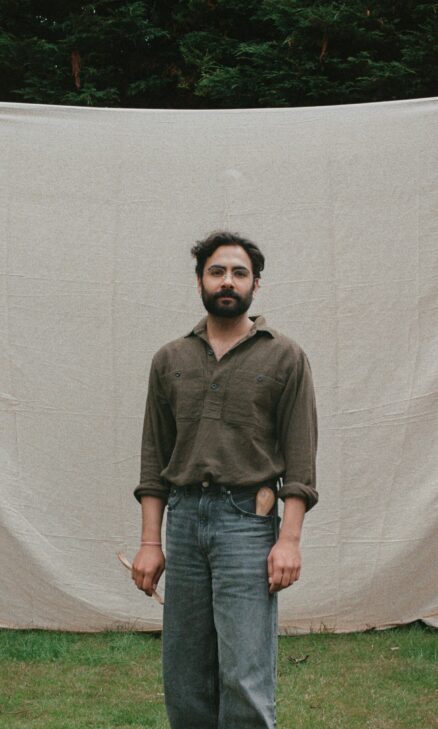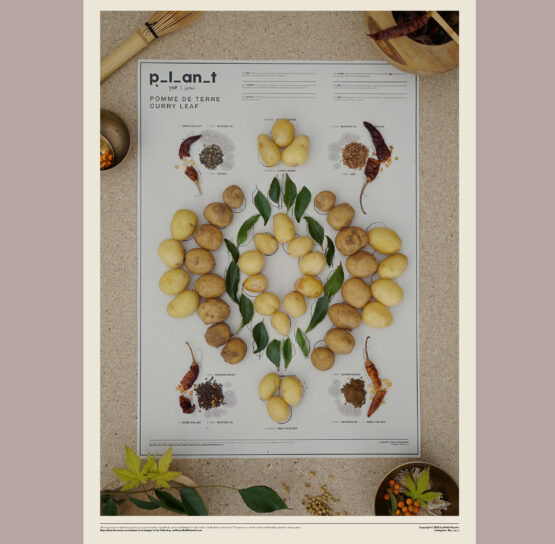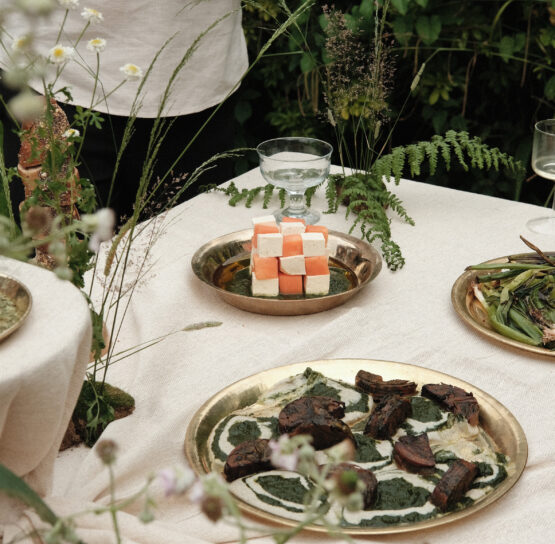Rohit Nandha
Rohit Nandha is a designer blending his architectural expertise with a passion for food, using design to transform plant-based recipes into accessible art. His work redefines how we experience food, merging creativity, culture, and nourishment into visually engaging projects.
Designer Rohit Nandha has a background in architecture but his love for food has brought together two seemingly different disciplines. While such an intersection may seem unconventional, his work demonstrates how the precision and technical skills of architecture can be applied to reshaping our understanding of food, creating new ways to experience and engage with it. Among Rohit’s standout projects is a research initiative titled p_l_an_t, where he transforms plant-based recipes into visually appealing ‘posters’. These are single-page recipes —as opposed to an elaborate traditional cookbook— that resemble a plan drawing; an architecture blueprint. Through this approach, Rohit emphasizes the accessibility and beauty of plant-based cooking, using design to make it more inviting. Prior to this, Rohit’s portfolio spans residential projects, masterplans, and restaurant designs, and contributions to international art biennales. But, it was his experience in spatial design that shaped p_l_an_t — during which he learnt the scopes of plant-based futures and urban farming. He now shares this interdisciplinary approach with students at Central Saint Martins, encouraging them to investigate the convergence of food and architecture. Additionally, Rohit integrates cultural narratives into his work. He highlights Indian communal practices such as Sevā, the selfless service observed in Gurudwaras and presents them graphically in his designs. Meanwhile, through Dining—installations which feature aesthetically arranged vegan meals— he creates moments of appreciating the beauty of food. In today's fast-paced world, where instant gratification and hyper-convenience often take priority, Rohit encourages a thoughtful shift by treating each meal as a poetic experience, recognising it as a source of deeper nourishment rather than a daily obligation for sustenance.



Rohit speaks to Blur The Border :
Blur : What sparked your interest in food after your educational and professional background in architecture?
Rohit : From a young age, I felt torn between the design field and the culinary world. Ultimately, I chose architecture because I saw it as a challenge that would push me to grow in new ways.
I was fortunate to study at an art school that encouraged us to think beyond the conventional boundaries. While architecture is often seen in a literal sense—like designing houses or skyscrapers —I discovered it has countless avenues and can connect with so many other aspects of life.
When I dove into themes like a plant-based future and urban farming, exploring how design can influence the way we eat and think about food, I wanted to inspire younger generations to understand that what they put on their plates can have a big impact on the environment and the food system as a whole.
Blur : What similarities do you find between food and architecture in terms of the creative process or otherwise?
Rohit : In architecture, you’re designing something deeply personal, tailored to a specific client and site. It involves understanding needs, exploring possibilities, and refining ideas over months or even years to create a space that feels just right. With food, it’s much the same. You’re crafting something unique, pouring thought and care into each dish, and presenting it in a way that feels personal and meaningful. The big difference—and what draws me more towards food—is the immediacy. I love how quickly you can see your ideas come to life, and the instant feedback you get when someone takes that first bite.
Whether it’s a beautifully designed space or a lovingly prepared meal, both have the power to make people feel seen, cared for, and at home.
Blur : The concept of "Poetics of Food" emphasizes a mindful connection to what we eat and seeing it as a form of poetry that enriches life. In our fast-paced, modern world, how do you see this concept getting translated?
Rohit : In our fast-paced world, where convenience often takes over, embracing this idea means shifting our view of food from mere fuel to a source of deeper nourishment.
Practically, this might involve cooking at home more often, valuing quality over quantity, and creating environments where food is celebrated rather than rushed. It also means reconnecting with the stories behind our food and understanding how our choices impact our well-being and the planet.
Blur : Do you have a definitive process while creating? Are there any habits or rituals that help you get into a creative mindset?
Rohit : Growing up in the Western world, I’ve learned to embrace a unique dual perspective in my projects. I’ve found that the best ideas often come to me spontaneously, so I allow them to flow naturally and act on them when they feel right.
My background in architecture greatly influences how I approach my work. I love weaving narratives and stories into my presentations and mood boards. Sketches and drawings, like axonometric views, help me share my thought process in a way that’s both clear and creative.
Blur : You have chosen simple, nourishing plant-based dishes for your project. What drew you to these particular recipes, and how do they reflect the cultural or emotional connections you have with food?
Rohit : Growing up in a vegetarian household instilled in me a deep appreciation for plant-based cuisine, with recipes that reflect our rich South Asian heritage. These dishes, passed down through generations, remain largely unexplored in Western culinary contexts.
My creative process intertwines traditional Indian art and storytelling—drawing inspiration from Hindu myths, tantric symbols, and folk art. For instance, my ‘Stuffed Gujarati Aubergine’ is influenced by both my grandmother’s recipes and the vibrant hues of the vegetable, evoking the goddess Kali. The aubergine's colors and shape symbolize the goddess’s diverse forms, while the Kalighat paintings from rural Bengal add depth and artistry to the dish. They offer a sense of comfort and nostalgia while showcasing the beauty of our traditions to a wider audience.
Blur : Your works also explore the broader role of food in our lives through "Seva" and Dining. Can you elaborate on your philosophy behind these?
Rohit : In London, where so many cultures come together, I’m really interested in how different communities share their traditions. Through Seva I wanted to show how it isn’t just a religious ritual observed at Gurudwaras but something that can be a part of our everyday lives, helping to build strong, supportive communities.
On the other hand, Dining is something I’m starting to look at more artistically with P_L_AN_T. I want to turn dining into a richer experience that’s both enjoyable and meaningful, where we can appreciate the beauty of food and the joy of sharing it with others.
Both Seva and Dining show how food can be a powerful way to connect with people and make life more meaningful. Whether it’s through acts of giving or creating beautiful dining moments, food has an amazing ability to bring us closer together and make our experiences richer.
Blur : How do you think the cross-pollination of two different disciplines will shape the future of design and creativity?
Rohit : Bringing together two distinct areas can lead to fresh ideas and new ways of thinking. This kind of crossover encourages us to break out of traditional boxes and explore new solutions. It could lead to innovative ways to tackle challenges, like blending eco-friendly design with architecture or reimagining food systems with a mix of culinary and environmental know-how.
It helps us dream up and build a future where design and creativity are more connected and responsive to what we need.
Blur : Are you hoping to integrate these recipes into daily people's lives, or do you view them more as an artistic and educational endeavor?
Rohit : The goal is for people to see them not just as art, but as something they can incorporate into their everyday routines. By simplifying plant-based cooking and making it visually appealing, I hope to encourage more people to embrace a plant-based diet and make it a regular part of their lives.
I aim to strike a balance where these recipes serve as both a source of inspiration and a practical tool, enriching daily life while also celebrating the art of cooking.
Blur : If you were to collaborate with other artists, outside of your discipline, what is one collaboration you would love to do?
Rohit : I’m excited to dive deeper into hands-on projects that blend cultural heritage with unique, artful experiences, particularly in the realm of events and dining. While the Western world has already begun to explore innovative ways to intertwine food with playful, artistic contexts, I see a vast opportunity to uncover and celebrate the rich cultural heritage of South Asia in similar ways.
Collaborating with like-minded brands and artists who value craftsmanship and creativity is a path I’m eager to explore.